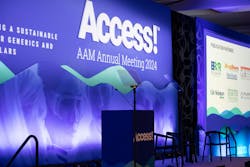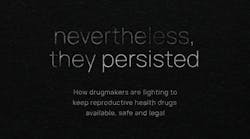AAM’s Access! 2024 made its Tampa, Florida debut back in February, bringing together industry leaders and decision-makers to explore the business, breakthroughs and politics that shape the future of generic drugs.
The generic and biosimilar industry faces unprecedented threats to long-term sustainability,” warned David Gaugh, AAM’s interim president and CEO, in the opening plenary.
During the annual meeting, panelists tackled the issues behind the increasing fragility of the industry that supplies more than nine out of every 10 prescriptions in the U.S. Price deflation, unfavorable policy, pharmacy benefit managers and biosimilar uptake were top of mind.
Price deflation
Affordable prices are what make generics the ‘backbone of the prescription drug market.’ The average generic copay is $6.16 versus the average brand copay of $56.12, according to AAM data. And while this is great news for patients, in some cases, low price points have led to unintended consequences for the generics industry.
Driven by increased volume and new generic launches, generic prices in the U.S. have been deflating. Doug Long, vice president of industry relations at IQVIA (and also a long-time fixture at AAM events and winner of the AAM Lifetime Achievement Award) presented a startling statistic: In 2018, it took total sales from eight brand drugs to equal the total generics business; in 2023 it took sales from just two drugs — AbbVie’s Humira and Novo Nordisk’s Ozempic.
It has become increasingly difficult for drugmakers to survive in the highly competitive, low margin industry — a reality that was frequently mentioned during the conference. “The economics of the generics industry are untenable,” said Keren Haruvi, AAM board chair and president, Sandoz North America.
The financial challenges facing the sector have in some situations forced generics manufacturers to reconsider making older drugs. Market withdraws are frequent — an average of one generic drug has gone off market every other day for the last decade, pointed out Gaugh.
A multitude of factors are contributing to the drug shortage problem in the U.S., but the financial headwinds faced by generics play a role. High profile shortages of antibiotics, chemotherapies and ADHD drugs have captured the attention of policymakers and government agencies. While shortages affect both branded drugs and generics, they are more common at lower price points — more than half of the drugs currently on shortage are priced less than $1, according to Long.
Unfavorable policy
While the battle against policy is not a new one for the generics industry, this year, it was the Inflation Reduction Act’s turn to be in the hotseat.
Passed into law in 2022, the IRA mandates that drug manufacturers pay a rebate to the federal government if the prices of certain drugs covered under Medicare rise at a rate that exceeds inflation. Though the policy’s intended target is ‘Big Pharma’ and branded drugs, the generics industry will also feel the ripple effects.
“It’s actually one of the areas where there is some alignment between pharma and AAM,” said Brian Hoffmann, president, U.S. Generics, Hikma Pharmaceuticals, during the ‘CEOs unplugged’ panel. “The impact that this has on prices of branded drugs eventually will impact our generics industry.”
The IRA allows Medicare to negotiate prices for branded drugs with pharma companies, but these provisions come with uncertainties in terms of which branded drugs will be subjected to negotiations and when, as well as what the price will be. Because generic manufacturers make business decisions about which drugs to target years in advance, these unanswered questions create risk.
All is not lost though, with some panelists expressing hope that going forward, Congress might be convinced to make changes that could protect generics and biosimilars.
“My hope with the IRA is that we can shape it in a way that encourages preference for generic competition,” said Hoffmann.
Slow biosimilar uptake
Although biosimilars are delivering on their promise of lower prices — averaging around 50% less than reference brand biologics — adoption in the U.S. has been slower than anticipated.
“No country in the world has achieved the level of generic penetration like the U.S. — but why is that not being replicated in biosimilars?” probed Arunesh Verma, president and CEO at Cipla North America. “Why are we not leading the world when it comes to biosimilar penetration?”
The most striking example discussed during the event was that of adalimumab. While the introduction of biosimilar competition in 2023 for the world’s best-selling drug, AbbVie’s Humira, should have been a watershed moment for biosimilars, adalimumab biosims have captured less than 2% of the market share. Not only was this unexpected, but it is far below the average biosimilar market rate one year post-loss of exclusivity — 22%.
“Unfortunately, Humira has become the poster child for why we should leave biosimilars,” said Verma, “As result of lack of penetration, there are companies that have stepped away from biosimilars.”
While many panelists acknowledged that there is still work to be done in terms of educating health care providers about the safety and benefits of biosimilars, the bigger issue in the U.S. is a familiar foe to the broader generics sector — pharmacy benefit managers.
PBMs — the so-called ‘middlemen’ between drug manufacturers and pharmacies — have been accused of denying patients coverage of lower-cost generics and biosimilars by creating drug formularies that favor more expensive drugs. The rebate system, in which PBMs generate revenue from drugmakers when list prices are high, has proven especially damaging in the context of biosimilars, blocking patient access to more affordable medications.
Ultimately, the goal of AAM’s aptly-named Access! annual meeting — and the broader goal of the generic and biosimilar industry — is facilitating patient access to lifesaving medicines.
“Our challenge as we leave this meeting will be to continue our engagement, support and leadership in our collective goal to increase patient access to affordable medicines,” said Haruvi. “And while we are all — as companies and individuals — dedicated to achieving a future where patients can get the medicines they need at the right time and at the right cost, in this case, the whole is greater than the sum of its parts. We must work together to chart a sustainable path for generics and biosimilars.”




